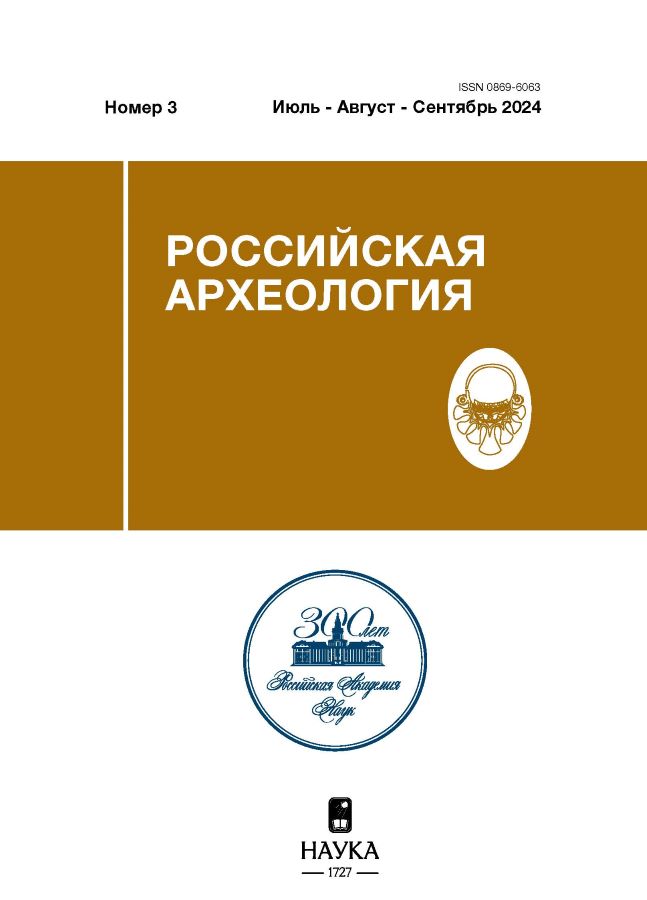Comprehensive study of the chekalino II site in the forest-steppe Volga Region (Mesolithic, final Bronze Age)
- Autores: Andreev K.M.1, Burygin M.A.1, Aleshinskaya A.S.2, Roslyakova N.V.1
-
Afiliações:
- Samara State Social and Pedagogical University
- Institute of Archaeology RAS
- Edição: Nº 3 (2024)
- Páginas: 21-37
- Seção: ARTICLES
- URL: https://permmedjournal.ru/0869-6063/article/view/655748
- DOI: https://doi.org/10.31857/S0869606324030024
- EDN: https://elibrary.ru/XAJXMF
- ID: 655748
Citar
Texto integral
Resumo
The article introduces the results of studying the Chekalino II site (Sergievsk District of Samara Region) in 2021 and discusses the characteristics of data obtained with natural science methods. The location of the site and the history of its study are presented. The authors describe stratigraphy of the site and the results of palynological analysis of the cultural layer. Detailed information about the categories of lithic inventory is provided with an emphasis on the tool set. The characteristics of the pottery collection are given. Based on radiocarbon dating, the study established chronological framework of functioning of the complexes. The analysis of the flint collection and absolute age data made it possible to determine the position of the site in the system of Mesolithic antiquities of the region. Typological, radiocarbon and archaeozoological results provide information about the period of residence of the final Bronze Age population and its economic activities.
Texto integral
Sobre autores
Konstantin Andreev
Samara State Social and Pedagogical University
Autor responsável pela correspondência
Email: konstantin_andreev_88@mail.ru
Rússia, Samara
Maksim Burygin
Samara State Social and Pedagogical University
Email: burigin.maxim@yandex.ru
Rússia, Samara
Anna Aleshinskaya
Institute of Archaeology RAS
Email: asalesh@mail.ru
Rússia, Moscow
Natalya Roslyakova
Samara State Social and Pedagogical University
Email: roslyakova_n@mail.ru
Rússia, Samara
Bibliografia
- Andreev K.M., Andreeva O.V., Aleshinskaya A.S., Kul’kova M.A., Burygin M.A., 2023. Kochkari I – a new Late Mesolithic site in the forest-steppe Volga River region (the research results). Rossiyskaya arkheologiya [Russian archaeology], 1, pp. 7–24. (In Russ.)
- Andreev K.M., Andreeva O.V., Kul’kova M.A., Oynonen M., 2020. The first data on radiocarbon chronology of the Mesolithic forest-steppe Volga region. Radiouglerod v arkheologii i paleoekologii: proshloe, nastoyashchee, budushchee [Radiocarbon in archaeology and palaeoecology: past, present, future]. St.Petersburg: Institut istorii material’noy kul’tury Rossiyskoy akademii nauk: Rossiyskiy gosudarstvennyy pedagogicheskiy universitet; Samara: Samarskiy gosudarstvennyy sotsial’no-pedagogicheskiy universitet: Porto-print, pp. 8, 9. (In Russ.)
- Andreev K.M., Lastovskiy A.A., 2021. Mesolithic of the forest-steppe Volga region. Arkheologiya Volgo-Ural’ya [Archaeology of the Volga-Ural region], 1. Kamennyy vek. Kazan’: Akademiya nauk Respubliki Tatarstan, pp. 185–194. (In Russ.)
- Chizhevskiy A.A., Lyganov A.V., Kuz’minykh S.V., 2021. The Maklasheyevka culture. Arkheologiya Volgo-Ural’ya [Archaeology of the Volga-Ural region], 2. Eneolit bronzovyy vek [Chalcolithic. Bronze Age]. Kazan’: Akademiya nauk Respubliki Tatarstan, pp. 601–637. (In Russ.)
- Grimm E.C., 2004. TGView 2.0.2 (computer software). Illinois State Museum.
- Grimm E.C., 2019. TILIA 2.6.1 version (computer software). Illinois State Museum.
- Khlobystin D.P., 1996. Eastern Siberia and the Far East. Neolit Severnoy Evrazii [Neolithic of Northern Eurasia]. Moscow: Nauka, pp. 270–328. (In Russ.)
- Kolev Yu.I., 2000. The final stage of the Bronze Age in the Volga River region. Istoriya Samarskogo Povolzh’ya s drevneyshikh vremen do nashikh dney. Bronzovyy vek [History of the Samara area of the Volga River region from ancient times to the present day. Bronze Age]. Samara: Samarskiy nauchnyy tsentr Rossiyskoy akademii nauk, pp. 242–301. (In Russ.)
- Korolev A.I., Lastovskiy A.A., Mamonov A.E., 1997. Mesolithic complex of the Chekalino II site. Istoriko-arkheologicheskie izyskaniya [Historical and archaeological research], 2. Samara: Samarskiy gosudarstvennyy pedagogicheskiy universitet, pp. 3–13. (In Russ.)
- Kosmenko M.G., 1972. The main stages of the Mesolithic culture in the Middle Volga region. Sovetskaya arkheologiya [Soviet archaeology], 3, pp. 3–17. (In Russ.)
- Lastovskiy A.A., 1999. Lithic inventory of the Krasny Yar Mesolithic site. Okhrana i izuchenie pamyatnikov istorii i kul’tury v Samarskoy oblasti [Protection and study of historical and cultural monuments in Samara Region], 1. Samara: Samarskiy gosudarstvennyy pedagogicheskiy universitet, pp. 4–24. (In Russ.)
- Lastovskiy A.A., 2000. Mesolithic. Istoriya Samarskogo Povolzh’ya s drevneyshikh vremen do nashikh dney. Kamennyy vek [History of the Samara area of the Volga River region from ancient times to the present day. Stone Age]. Samara: Samarskiy nauchnyy tsentr Rossiyskoy akademii nauk, pp. 81–140. (In Russ.)
- Levkovskaya G.M., 1995. Conclusion based on the results of spore-pollen analysis of samples from cross-sections of sites in the Ivanovsky microdistrict on the river Tok. Morgunova N.L. Neolit i eneolit yuga lesostepi Volgo-Ural’skogo mezhdurech’ya [Neolithic and Eneolithic of the southern forest-steppe in the Volga-Ural interfluve]. Orenburg: Orenburgskiy gosudarstvennyy pedagogicheskiy institut, pp. 173–176. (In Russ.)
- Matyushin G.N., 1976. Mezolit Yuzhnogo Urala [Mesolithic of the Southern Urals]. Moscow: Nauka. 368 p.
- Mel’nichuk A.F., 2021. Mesolithic of the Upper and Middle Kama region. Arkheologiya Volgo-Ural’ya [Archaeology of the Volga-Ural region], 1. Kamennyy vek [Stone Age]. Kazan’: Akademiya nauk Respubliki Tatarstan, pp. 203–214. (In Russ.)
- Morgunova N.L., 1983. The Starotok Mesolithic site. Drevnie pamyatniki na territorii Vostochnoy Evropy [Ancient sites on the territory of Eastern Europe]. Voronezh: Voronezhskiy gosudarstvennyy pedagogicheskiy institut, pp. 28–40. (In Russ.)
- Okladnikov A.P., 1950. Neolit i bronzovyy vek Pribaykal’ya. Istoriko-arkheologicheskoe issledovani [Neolithic and Bronze Age of the Baikal region. Historical and archaeological research], I, II. Moscow; Leningrad: Izdatel’stvo Akademii nauk SSSR. 412 p. (Materialy i issledovaniya po arkheologii SSSR, 18).
- Pyl’tsevoy analiz [Pollen analysis]. I.M. Pokrovskaya, ed. Moscow: Gosgeolizdat, 1950. 540 p.
- Stockmarr J., 1973. Determination of spore concentration with an electronic particle counter. Danmarks Geologiske Undersøgelse, pp. 87–89.
- Viskalin A.V., 2008. The Khovrino Mesolithic site. Chelovek, adaptatsiya, kul’tura [Man, adaptation, culture]. Moscow: Institut arkheologii Rossiyskoy akademii nauk, pp. 228–239. (In Russ.)
Arquivos suplementares

















